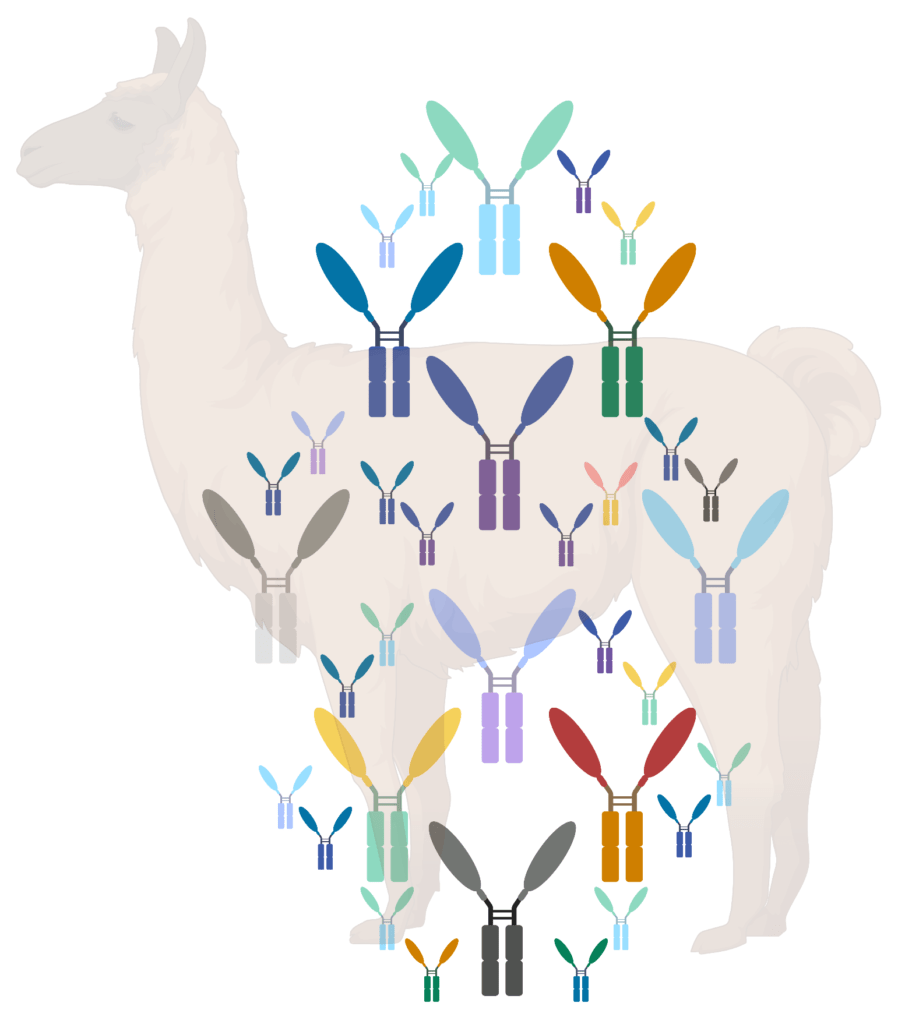Jotbody - Single-Domain Antibody (sdAb) Products & Services
High-quality camelid nanobody (VHH) and shark nanobody (vNar)
Jotbody adopts a cost-effective and short-cycle workflow for the discovery of single-domain antibody (sdAb), also called nanobody from Camel, Alpaca, Llama (VHH) and Shark (vNar). They provide sdAb products, discovery, engineering services, production and functionalization, all of outstanding quality.
With a size of just 15 kDa (2~4 nm), nanobody is the smallest antigen-binding fragment discovered today and holds a plethora of intrinsic advantages over conventional monoclonal antibodies.
Camelid and Shark Single-domain antibody (sdAb, Nanobody)

SdAb has a size of just 15 kDa (2~4 nm) and is the variable region isolated from the antigen-binding variable domain (VHH) of camelid heavy chain-only antibody or the variable domain (vNar) of shark immunoglobulin new antigen receptor (IgNar).
Why are sharks a valid alternative for sdAb discovery?
- vNar, evolutionarily distant from mammal VH domains, is best for detecting human antigen
- vNar owns a peculiar paratope structure suitable for enriching the epitope diversity of antigen
- The high concentration of urea in the shark blood forges antibodies that are highly resistant at high pH, temperature, and organic solvent
Single-domain Antibody vs. Conventional Antibody
Single-domain Antibody
- Simple architecture
- High thermal & chemical stability
- Good solubility
- High tissue penetration
- Broad target applicability
- Multiple administration routes
- Great and easy modularity
- Readily formatting
- Large-scale production
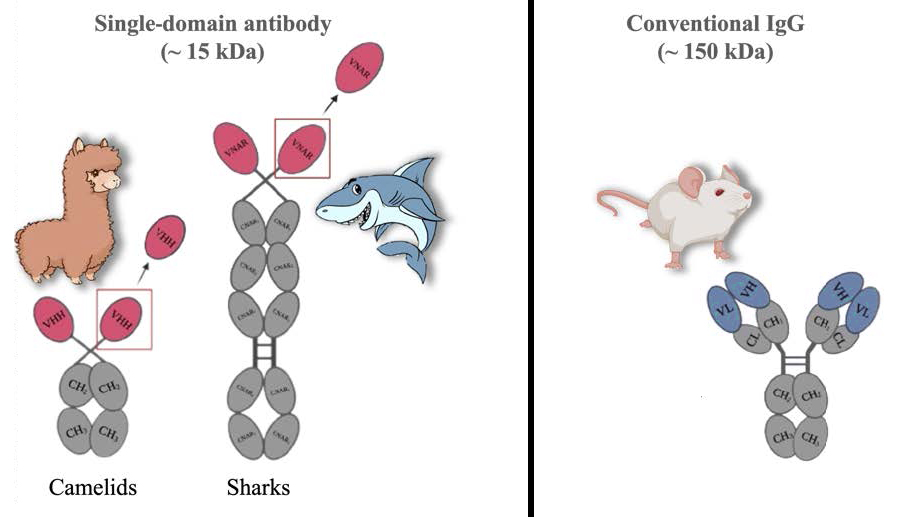
Conventional Antibody
- Complex structure
- Poor stability
- Poor tissue penetration
- Long serum half-life
Characteristics
Size
Binding affinity
Batch to Batch consistency
Novel epitope
Solubility (aggregation escape)
Stability (temperature & pH)
Single-domain antibody
~15 kDa
pM to nM ranged kD
Very high
Yes
High
High
Conventional antibody
~150 kDa
nM to μM ranged kD
High (subjected to genetic drift)
N/A
Very poor
Low
What Jotbody offers...
1. Catalog Nanobodies - Growing catalog!
Jotbody offers growing range of high-quality sdAb from camelids (VHH) and shark (vNar).
All Nanobodies are thoroughly tested using advanced technologies and multiple applications to ensure the highest level of specificity, sensitivity, and reproducibility.

So far, the catalog includes nanobodies against popular targets from the following areas:
- Cancer and Immunotherapy
- Infectiology & Toxins
- Fluorescent Proteins & Cell Biology
Anti-PD-L1 VHH Antibody - JOT0002-5
Reactivity: Human/Cynomolgus macaques
Applications: ELISA, WB, IHC, IF
ELISA
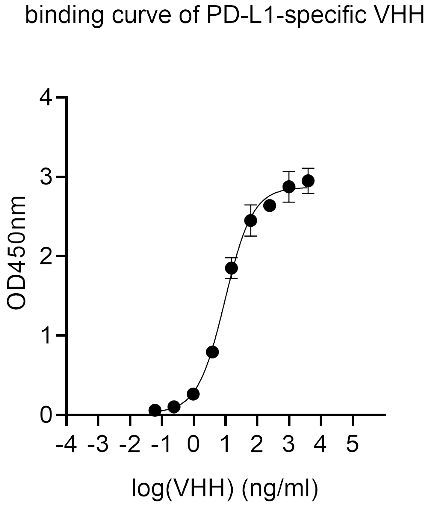
Indirect ELISA showing anti-PD-L1 VHH antibody (JOT0002-5) binding to purified PD-L1. Plates were coated with 200 ng of purified protein and the binding of JOT0002-5 was assessed in serial dilution from 0.06ng/ml primary antibody in triplicate.
WB

Lysates of PLC cells were subjected to SDS PAGE followed by western blot with anti- PDL1 VHH antibody (JOT0002-5) at dilution of 1:3000 and incubated overnight at 4°C.
SPR
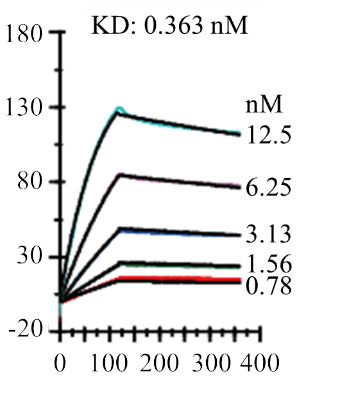
Captured human PD-L1 on CM5 Chip can bind anti-PDL1 VHH antibody (JOT0002-5) with an affinity constant of 0.363 nM as determined in SPR assay (Biacore T200).
IF

Immunofluorescence analysis of paraformaldehyde-fixed MCF-7 cells stained with anti-PD-L1 VHH antibody (JOT0002-5) at 2.5 μg/ml followed by CoraLite. 488 secondary antibody at 1:200 dilution, showing cytoplasmic staining (under 40x lens). The nuclear stain is DAPI (blue). The isotype control was stained with anti-unknown antibody followed by CoraLite. 488 secondary antibody (under 20x lens).
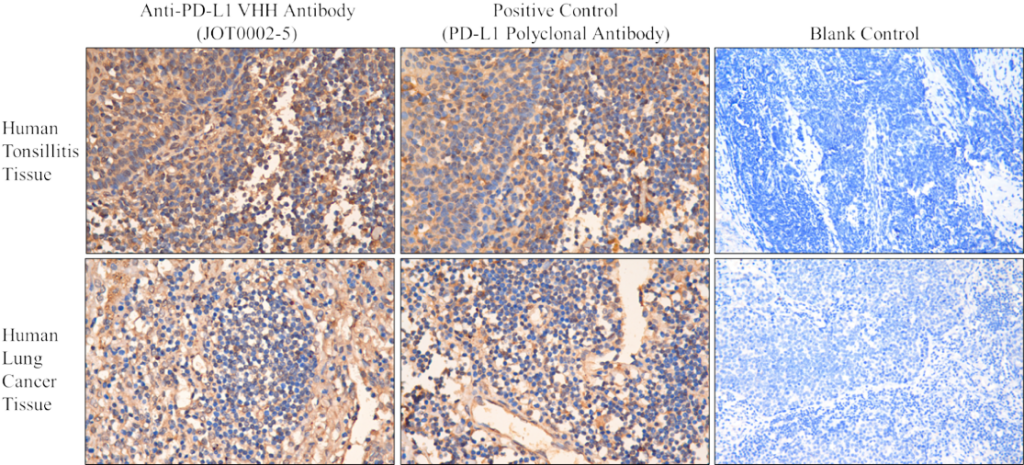
IHC
Immunohistochemical analysis of paraffin-embedded human tonsillitis tissue and human lung cancer tissue slides using anti-PD-L1 VHH antibody (JOT0002-5) at 2.5ug/ml and positive control (PD-L1 polyclonal antibody, a competitor product) at 1:500 dilution (under 40x lens), respectively. Heat mediated antigen retrieval with Tris-EDTA buffer (pH 9.0).
Anti-hTNFR1 VHH antibody (TR09) - JOT0005-1
Reactivity: Human
Applications: ELISA, WB, IHC, IF
ELISA

Indirect ELISA showing anti-TNFR1 VHH antibody (JOT0005-1) binding to purified PD-L1. Plates were coated with 200ng/well purified protein and the binding of JOT0005-1 was assessed in serial dilution from 1 ng/ml primary antibody in triplicate.
WB
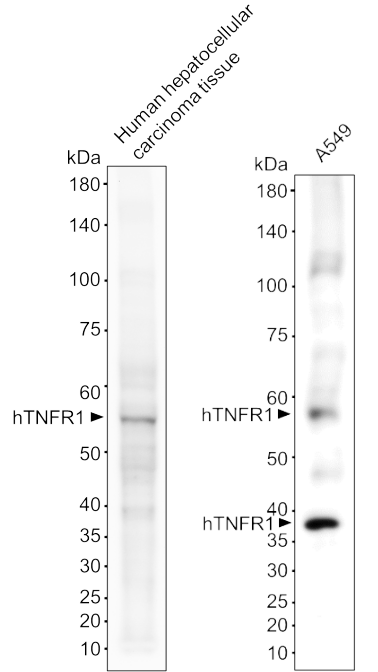
Lysates of human hepatocellular carcinoma tissue and A549 cells were subjected to SDS-PAGE followed by western blot with anti-TNFR1 VHH antibody (JOT0005-1) at dilution of 1:3000 incubated at room temperature for 1.5 hours.
IF

Immunofluorescence analysis of paraformaldehyde-fixed MCF-7 cells stained with anti-TNFR1 VHH antibody (JOT0005-1) at 2.5 μg/ml followed by CoraLite. 488 secondary antibody at 1:200 dilution, showing cytoplasmic staining (under 40x lens). The nuclear stain is DAPI (blue). The isotype control was stained with antiunknown antibody followed by CoraLite. 488 secondary antibody (under 20x lens).

IHC
Immunohistochemical analysis of paraffin-embedded human lung carcinoma tissue slides using anti-TNFR1 VHH antibody (JOT0005-1) at 2.5ug/ml and positive control (TNFR1 monoclonal antibody, a competitor product) at 1:200 dilution (under 20x lens), respectively. Heat mediated antigen retrieval with Tris-EDTA buffer (pH 9.0).
2. Animals Immunization for single-domain antibody discovery
Jotbody adopts a cost-effective, customizable, and short-cycle workflow for the discovery and production of sdAbs from camels, alpacas, llamas (VHH) and sharks (VNAR).
Jotbody general workflow includes up to 4 and 7 times of immunization with the antigen of choice for camelids and shark, respectively. After the last immunization, blood samples from the immunized animals are collected and the peripheral blood mononuclear cells are isolated for further analysis.
The whole immunization workflow takes 1-2 months for camelids and 3- 6 months for shark.
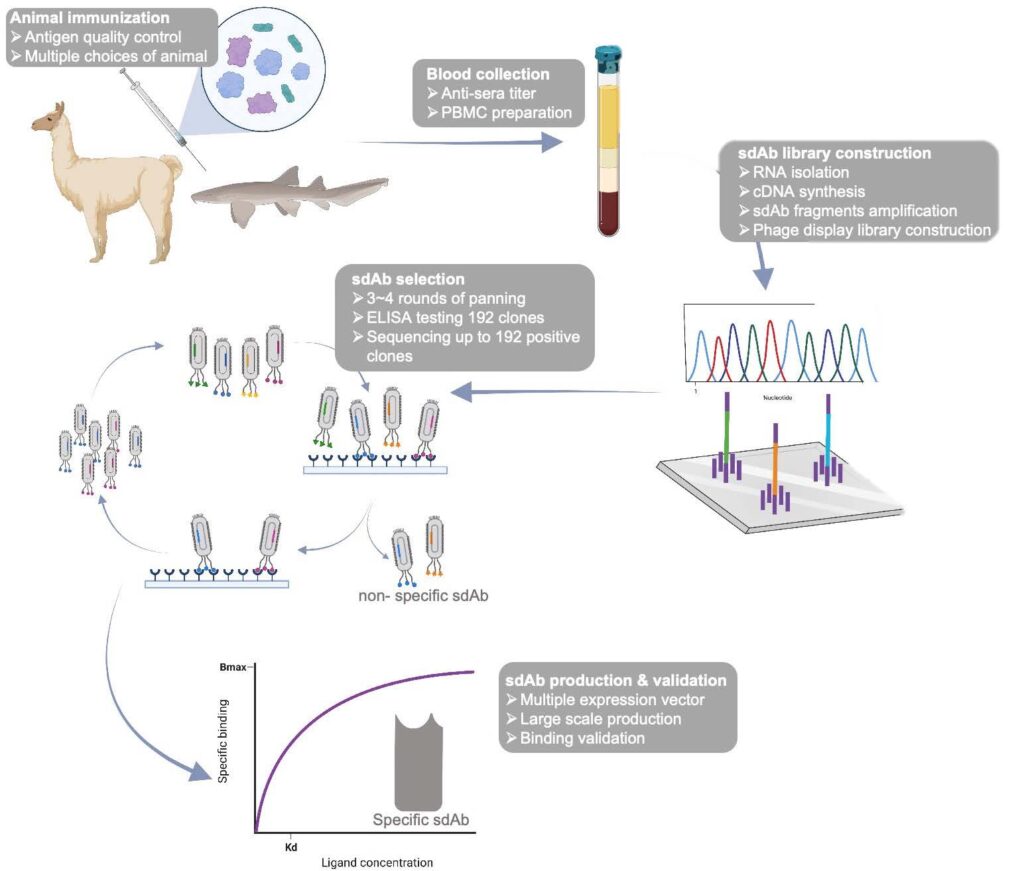
3. Immunized sdAb Phage Library
Specific sdAb can be isolated from an immune library or a naïve library. Without any doubt, the sampling of sdAb derived from an immune library offers better performances. When compared to naïve libraries, Immune libraries develop sdAb of greater affinity and excellent specificity to the antigen due to the natural selection occurring during the somatic maturation in lymphocytes of immunized alpaca, camel, llama or shark performs upon immunization.
However, animal immunization makes the development of Immunized sdAb Phage Library lengthy.
4. Naïve sdAb Phage Library
Naïve sdAb Phage Library is a valid alternative to Immunized sdAb Phage Library, and in light of the short turn-around time, Naïve sdAb Library is by far the most used strategy for the selection of new Ab. Naïve libraries are especially recommended for antigen with low immunogenicity, toxic, lethal, transmissible effects, or nonimmunogenic small molecular compounds.
Currently, Jotbody offers Naïve sdAb Phage Libraries obtained from PBMC isolated from 77 healthy, non-immunized camelids (51 Alpacas, 13 Llamas, 13 camels):
- 3 weeks to deliver the sdAb, 10 days to deliver the sdAb sequence
- Megadiverse naïve library containing 4.7 Å~ 1011 unique VHH clones
- Nearly 100% VHH insert rate

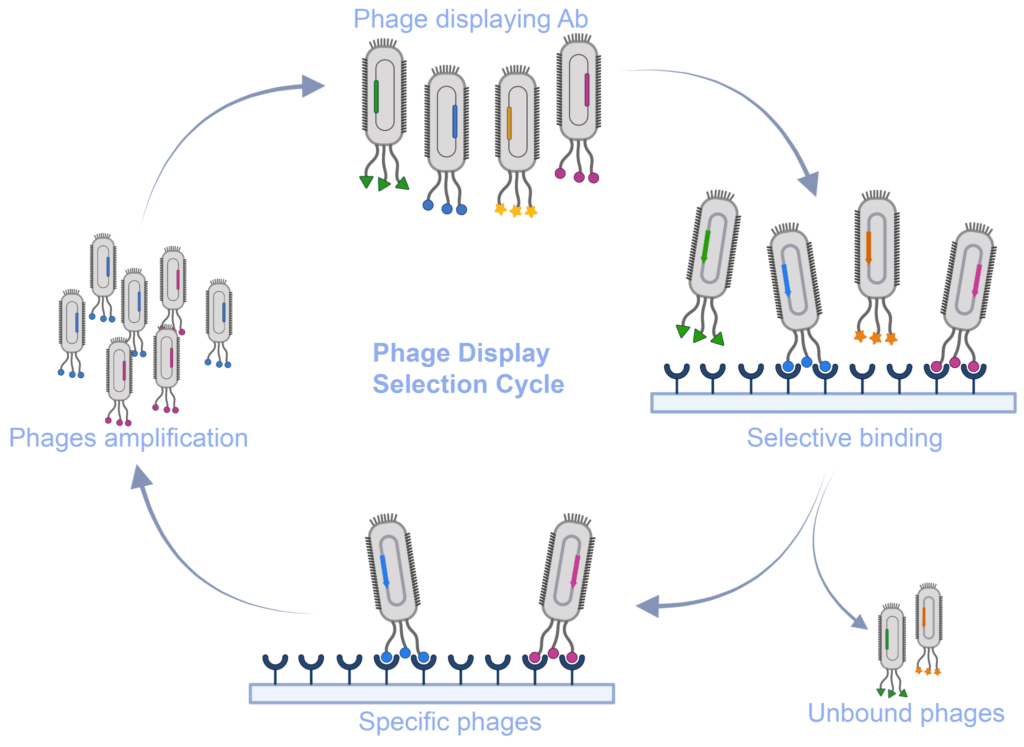
Naïve Library Screening service includes:
- analysis of customer-provided antigen
- 4 rounds of screening
- ELISA testing of 192 random clones
- sequencing up to 50 positive clone


